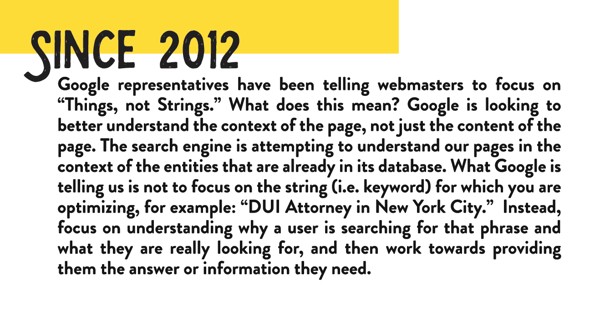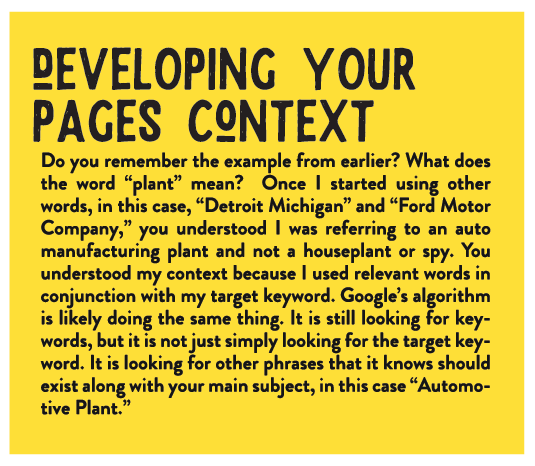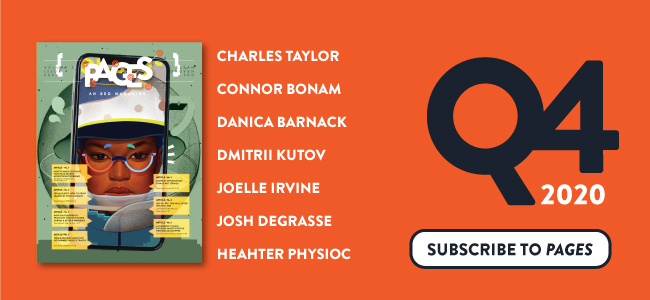Four Pillars of SEO
If you have watched any of my videos or webinars, you will have heard me speak about the four pillars of SEO that should be part of any website’s SEO strategy: Bot Accessibility, Relevance, Authority and Quality. For this article, I would like to hone in on the second pillar, relevance. Is the content on your page considered relevant for the search query for both the search engine AND the searcher?
All searches performed by users begin with a query, or search “string,” – the words you type into the search bar. Once you enter those words into the search bar, Google will then evaluate all of the pages it has in its index to determine if it is relevant for the query the searcher entered. Google will then present the resulting pages to you on the SERP (Search Engine Result Page).
But how exactly do Google and other search engines determine what is and is not relevant? It all begins with the content – mostly the copy – on your web page.
 If you approach the process from that angle, you will begin to understand better the pronouncement Googlers often make of, “just make great content.” It is NOT about trying to write for search engines. It is about writing for users but with search engines in mind. It is all about giving your content a greater level of topical depth and breadth – no matter who reads it.
If you approach the process from that angle, you will begin to understand better the pronouncement Googlers often make of, “just make great content.” It is NOT about trying to write for search engines. It is about writing for users but with search engines in mind. It is all about giving your content a greater level of topical depth and breadth – no matter who reads it.
Relevance – What does “plant” mean?
I will illustrate this with an example. If I say the word “plant,” what do I mean? This word has many different meanings. Am I speaking about horticulture? A houseplant, tree, bush, or weed in my garden – or maybe it is a verb, and I am referring to the act of planting one of those things? Maybe I am referring to a factory. Perhaps, I am discussing a spy within an organization. You simply do not know without the proper context.
Now, taking this same example, and I say the word “plant,” followed by the words “Detroit Michigan” and “Ford Motor Company.” Immediately you understand that I am referring to a factory. Specifically you know I am referring to an auto manufacturing plant. Why? Simple. I used other relevant words. These words gave greater context to the first word, or in our case, the search string.
In the “old days of SEO,” you simply had to place the target keyword on the page as many times as possible. Whoever was able to stuff the keyword onto the page the most, without triggering an automatic or manual penalty, would win – i.e. rank at the top of page #1 on Google.
Example: attorney, attorney, attorney, attorney
Over the years, things got a little more sophisticated. You could not simply use the same keyword repeatedly – Google got wise to this trick. You had to include variations of the keyword: singular, plural and phrases containing the keyword. If you really wanted to be clever, you might include a synonym or two.
Example: attorney, attorneys, attorney in NYC, lawyer

More content often equals better organic rankings
Many of us have seen ranking correlation charts. These studies show how more or less of a specific factor correlates with greater rankings. SEMRush has a great correlation study that they have been producing almost every year. In addition, in the yearly study, it is always shown that more content correlates strongly with higher rankings.
What this has led to is folks building “mega-pages.” Thinking that if they simply place more content on the page, it will magically rank better. Companies have spent untold dollars to simply, “put more content on the page.” I am suggesting that Google has gotten much more sophisticated than simply counting words on a page. If we dug into these content heavy pages, I suspect the reason why these pages rank is that they typically contain (either knowingly or unknowingly) the important context on the page – greater topical depth and breadth.
The good news I am here to tell you is that you most often DO NOT need to write pages laden with over a thousand words. Most of your existing pages could rank very well if they simply had the depth and breadth that Google expects for the topic.

Helping Google Understand Your Context
When optimizing content, I group the supporting words I need into one of three buckets:
- Match Words – As the group name implies, these words are all synonyms or abbreviations of your target word. They essentially mean the same (i.e. match) as the main keyword and can be used interchangeably. To find what Google considers a match is simple. When you perform a search for your target keyword, you will see that Google places these words in bold on the Search Engine Result Page (SERP). In our example, we will see that Google highlights “Auto Factory,” “Automotive Manufacturing,” and “Car Plant,” as well as others.
- Related Words – Whereas the first bucket contains interchangeable words, this group starts to give greater meaning to intent. These phrases sometimes contain synonyms, but not always. They can be found within Google’s Related Searches, AutoComplete, and the People Also Ask sections. This group tells you what to write. What searchers are trying to learn or discover. In our example, you would find “Assembly Line,” “Automotive plants near me,” and even “Automotive plant closures.”
- Co-Occurring Words – Lastly, these are words, if used by themselves, that would be no more helpful than a single keyword, but these terms are what Google believes should naturally appear in a conversation about this subject. These can be found using tools like LSI Calculators, and personally, I like using Google’s own NLP (Natural Language Processing) tool. In our example, you would get terms like “Ford Motor Company” and“Detroit, Michigan.” Just these two phrases alone tell you exactly what I am referring to, and I didn’t even have to use any synonyms or related terms – that’s how powerful these words can be for Google.
I have found that this is the key to building highly-relevant content. It is not just stuffing the keyword on your page. You need to include synonyms, related phrases, and now even co-occurring words as well. However, always remember: it is NOT about trying to write for search engines. It is about writing for users but with search engines in mind. It is all about giving your content a greater level of topical depth and breadth – no matter who reads it.
Taking Action
Here we are, at the end of the article. You may have learned something, but more importantly, will you put to use what you have learned? You now understand what Google likely means when they say “Strings, Not Things” and “Write Great Content.” Take this knowledge and put it to action today. There are many places you can use this new content optimization strategy: blog posts, product pages, service landing page, category pages, and even press releases. I suggest using the following outline to organize the process:
- Break up your content into groups by priority.
- Create an inventory list of pages for each group.
- Identify the target keyword(s) for each page.
- Research the “other words” for each, as we discussed.
- Adjust your page copy and optimize as needed.
- Repeat until you are complete.
Of course, this is not a quick and easy project, but few things worth doing are quick and easy. The goal is not to have a perfectly-optimized site. Quite honestly, as Google’s algorithm changes regularly, I am not sure it is possible to have a perfectly-optimized site. The goal is to be able to quantify what “great content” looks like to a search engine. This is how you satisfy the “relevance” pillar of your SEO site strategy.
As always, if you need help setting up or executing on this process, feel free to reach out to me for help: CharlesHarryTaylor@gmail.com
Subscribe to PAGES digital magazine. On the fly access. No waste, no clutter!


